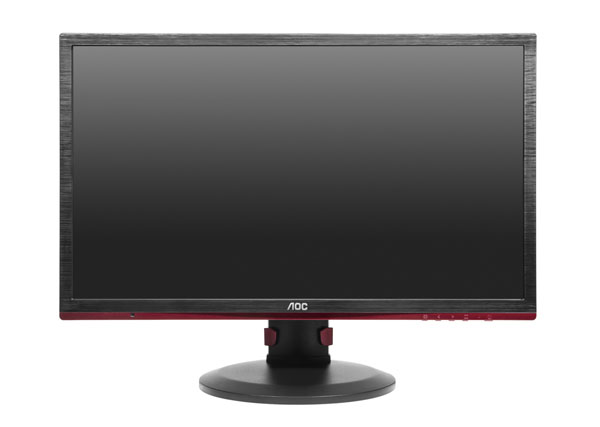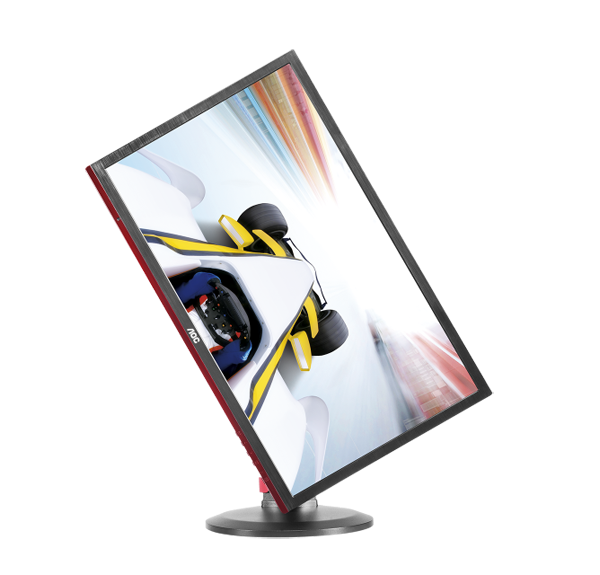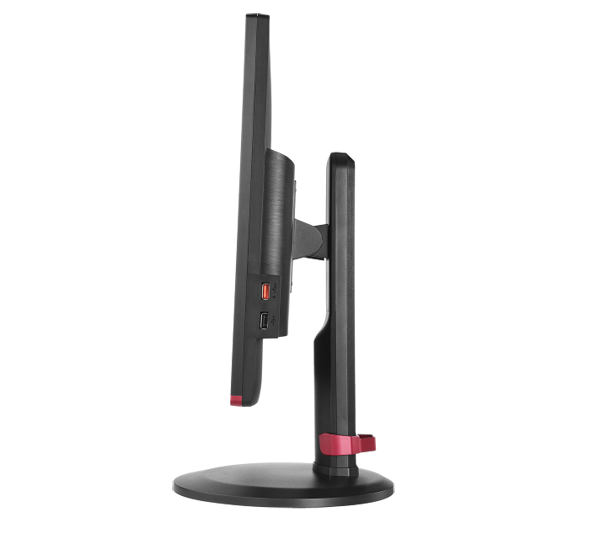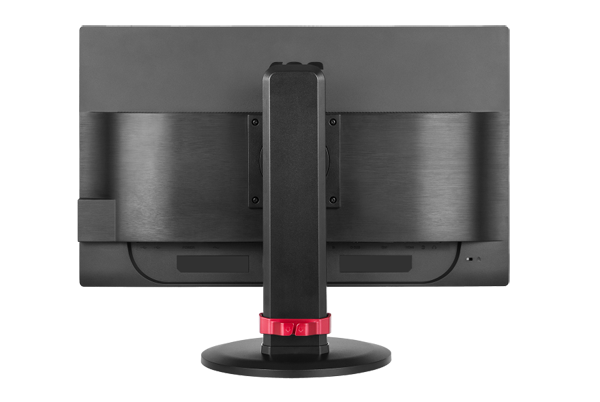AOC G2460PQU 24-inch 144 Hz Gaming Monitor Review
Not many monitors can run at 144 Hz, but AOC is adding to your list of choices with its G2460PQU 24-inch TN-based screen. We’ve already tested similar displays from Asus and BenQ. Can AOC match their speed and performance at a roughly $250 price point?
Why you can trust Tom's Hardware
Packaging, Physical Layout, And Accessories
Our sample arrived in a slim suitcase-style box made from sturdy double-corrugated cardboard. The contents are completely enclosed in Styrofoam, so it’s quite unlikely any damage will befall mail-order buyers. The cable bundle includes VGA, DVI, and USB 2.0, along with a standard IEC power cord for the internal power supply. There is no separate brick or wall wart to deal with. Also enclosed is a CD with the user manual, drivers, and AOC i-Menu software, which allows control of monitor functions from the Windows desktop (rather than the OSD).
Once unpacked, the only assembly required is to attach the base with its single captive wingnut.
Product 360
The first thing that catches my eye is the cool brushed finish of the bezel and the red stripe across the bottom. If style is an important factor in the design of your gaming rig, AOC's G2460PQU should satisfy you with its good looks. For those using multiple screens, a slim 15 mm side width means you can get those monitors fairly close together with only minimal interruption in the image. The display is fairly light in weight, so its small base is sturdy enough to keep everything upright.
Like the other gaming monitors we’ve tested recently, the anti-glare layer is medium-aggressive. It strikes a good balance between reflection mitigation and clarity. The image looks nice and sharp, and since we’re working with a 24-inch screen, its FHD resolution results in a pixel density of 92 ppi.
Speaking of the upright, it allows for a full range of ergonomic adjustments.
You can rotate the G2460PQU to portrait mode easily. But because the bottom bezel is a little wider at 25 mm, a multi-monitor setup in portrait mode isn't going to look as slick as a landscape configuration. The base allows nearly 300 degrees of swivel. You can also raise and lower the panel five inches, and tilt it up to 20 degrees back or five degrees forward. For a mid-priced product, the construction is quite solid. All of the screen's movements are precise and sure. Gamers concerned about getting just the right position in front of their screens should enjoy the flexibility that AOC enables.
Measuring two inches thick, the panel is a tad slimmer than others we’ve seen. The upright has a cable management bracket that snaps on and slides up and down. You’ll notice there are two side-facing USB ports, one of which is red. That connector can charge a peripheral device, be it your smartphone, camera, or tablet, so long as the monitor is in standby. It doesn’t even need to be connected to your PC. Very cool!
Get Tom's Hardware's best news and in-depth reviews, straight to your inbox.
The brushed finish continues around back, covering the bulge. Everything else is finished in traditional matte-textured plastic. Below the bulge you can see the speaker vents. Like all of the built-in drives we've auditioned, they reproduce high-mid frequencies reasonably well, but little else. Gamers definitely want to use a headset or high-quality 2.1-channel speaker system. Removing four screws reveals a 100 mm VESA mount for use with aftermarket brackets and arms.
AOC leaves a legacy VGA input on its panel, along with one DVI, HDMI, and DisplayPort 1.2 connector. On the far right are the audio input and headphone output. The left side contains the power jack, plus a toggle switch if you want to save even more power than standby mode enables. Last, you have the USB upstream port and two additional downstream connections.
Current page: Packaging, Physical Layout, And Accessories
Prev Page Can A 144 Hz FHD Display For $250 Achieve Gaming Nirvana? Next Page OSD Setup And Calibrating AOC's G2460PQU
Christian Eberle is a Contributing Editor for Tom's Hardware US. He's a veteran reviewer of A/V equipment, specializing in monitors. Christian began his obsession with tech when he built his first PC in 1991, a 286 running DOS 3.0 at a blazing 12MHz. In 2006, he undertook training from the Imaging Science Foundation in video calibration and testing and thus started a passion for precise imaging that persists to this day. He is also a professional musician with a degree from the New England Conservatory as a classical bassoonist which he used to good effect as a performer with the West Point Army Band from 1987 to 2013. He enjoys watching movies and listening to high-end audio in his custom-built home theater and can be seen riding trails near his home on a race-ready ICE VTX recumbent trike. Christian enjoys the endless summer in Florida where he lives with his wife and Chihuahua and plays with orchestras around the state.
-
PandaV4 I have a AOC G2460P monitor myself, and a unpleasant surprise was that refresh rate of 144 Hz wasn't supported if using the DisplayPort connection. Does G2460PQU have the same limitations, or does it actually support 144 Hz over DisplayPort?Reply -
PandaV4 After some googling it seems that G2460PQU and G2460P is the same model. So beware if you want to use Displayport you wont be able to use the 144 Hz setting too! And this doesn't have any blur reduction either! It seems there is actually a new updated model to be released this month the AOC G2460PG. And it has nvidia g-sync support and blur reduction, and supports 144 over dIsplayport.Reply
TL;DR: G2460PQU = DO NOT BUY, G2460PG = BUY. -
ceberle Reply13687399 said:I have a AOC G2460P monitor myself, and a unpleasant surprise was that refresh rate of 144 Hz wasn't supported if using the DisplayPort connection. Does G2460PQU have the same limitations, or does it actually support 144 Hz over DisplayPort?
The PQU does accept 144 Hz over DisplayPort.
-Christian- -
PandaV4 Reply
A bit of googling brought up this article - http://pcmonitors.info/reviews/aoc-g2460pqu which says: " The image provided by DisplayPort is very similar on this monitor and it should also support the maximum (144Hz) refresh rate. Unfortunately that was not the case during our testing" and "The PC resolutions below this should feature 1920 x 1080 with 100Hz, 120Hz and 144Hz selectable – but that isn’t the case.". It seems there are different revisions of this monitor with the same model number. So if you buy one of those than you are practically gambling about the 144 Hz support.13688062 said:13687399 said:I have a AOC G2460P monitor myself, and a unpleasant surprise was that refresh rate of 144 Hz wasn't supported if using the DisplayPort connection. Does G2460PQU have the same limitations, or does it actually support 144 Hz over DisplayPort?
The PQU does accept 144 Hz over DisplayPort.
-Christian-
-
npyrhone Will we ever see here a review of even one non-TN gaming monitor? The reduced color depth renders to image quality absolutely disgusting.Reply
I will be the first one to congratulate you when you publish the next review of a monitor with a non-TN panel working over 60Hz. -
3Dns I have that model too and i buy it after a HP 23xi IPS LED Panel.Reply
I understand that.
It doesnt worth 300€ for this model. All you need is 60hz and 24" Panel that you can take it with 120€. For me IPS Panels offer you way better colors so for me its better. Now if you want it for a GTX780 and above and you wanna play over 60FPS it may worth.
But have in mind that a normal monitor cost ~120$ and this model cost double. You can spend that money in other hardware areas like better GPU for example. -
Adroid Sorry, but I won't ever buy another 1080p "gaming" display. 1920x1200 is vastly superior for "gaming" screens, and it's a shame the industry has veered away from it.Reply
I guess the thought process involves "and you can watch HD movies on it". Needless to say the 16:9 ratio is cheaper for manufacturers, and it's a great sales pitch. Well, give me a break. I got suckered into that line of thinking and I probably watched 2-3 movies on my "gaming" 23 inch monitor in 4-5 years.
Let's keep the movies where they belong in the living room and re-focus "gaming" screens where they should have never left - in the 16:10 aspect ratio. -
alchemy69 If a game isn't enjoyable at 60Hz it isn't going to be enjoyable at 144Hz. And if it is enjoyable at 144, it still will be at 60. I've had some of the greatest fun over the last 30 years playing on tiny monitors, at low resolution and probably less than 30fps. I don't need the industry telling me what I need to have fun just so they can move more product.Reply




